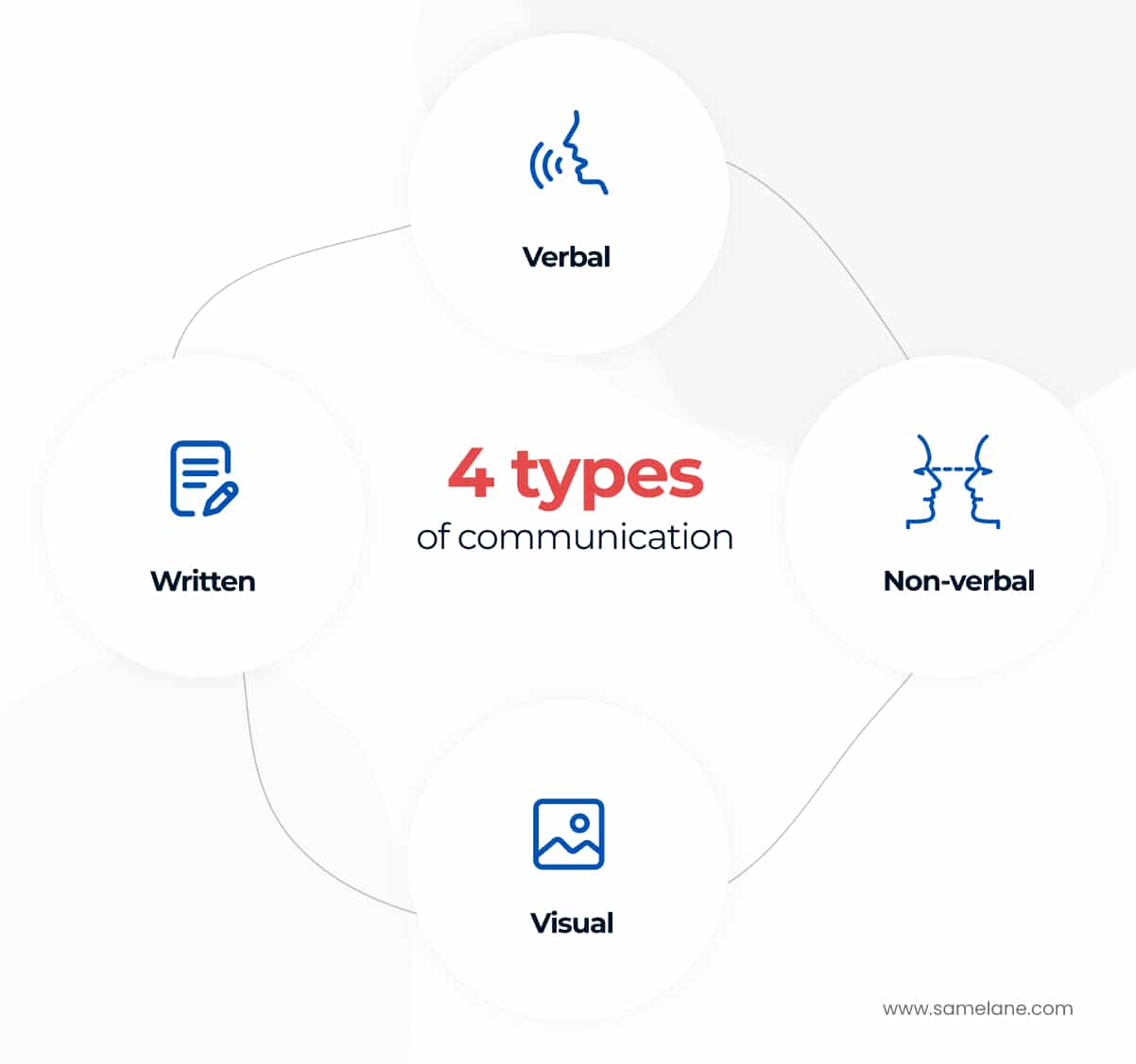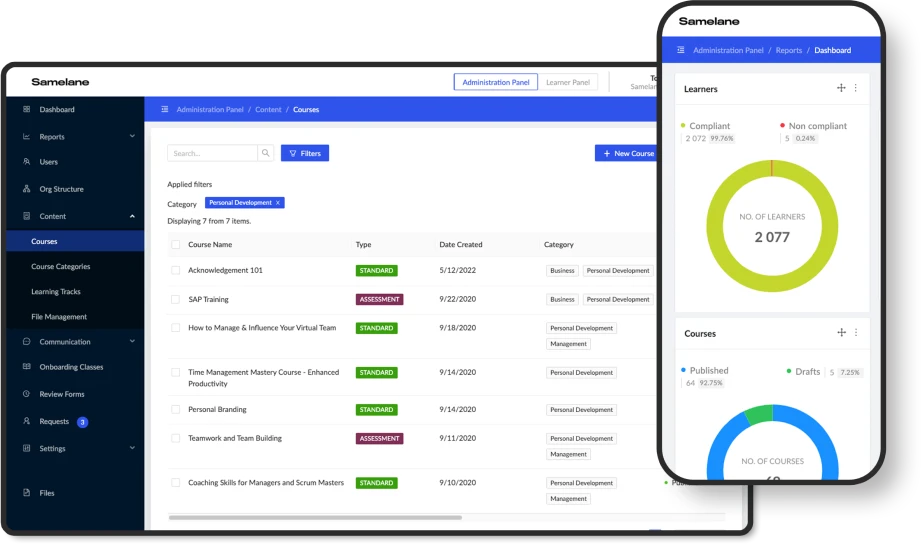Communication is a fundamental human process that allows us to share our thoughts, ideas, and feelings. The saying “Good communication is the bridge between confusion and clarity” is often attributed to Nat Turner, a 19th-century slave rebellion leader. Regardless of its origin, the truth of this statement resonates even more strongly in today’s complex and fast-paced world.
What is communication?
Communication is an exchange. It’s a two-way passage of transmitting and receiving messages. When we communicate, we are in a process by which information is exchanged between people through a common system of signs, symbols, or behavior. Simple as it may seem, sharing a message often generates communication issues.
So, how can you get through with your information effectively? Which soft skills should we put to use? And finally, what are the key barriers we stumble upon in the process?
Importance of effective communication
The aim of communication comes down to composing and forwarding a message that is understandable to the receiver. It is essential for building relationships, fostering collaboration, achieving goals, and resolving conflicts. It’s a cornerstone of successful interaction in all aspects of life, from personal relationships to professional settings.
Effective communication is crucial in all aspects of life, but it holds particular importance for several reasons:
- Enhanced relationships and collaboration: Effective communication builds trust, respect, and empathy, which are essential for strong relationships, both personal and professional. In a business environment, it allows teams to collaborate effectively by clearly sharing information, ideas, and goals.
- Improved understanding: Effective communication ensures that the receiver understands the message you intend precisely. It reduces confusion, misinterpretations, and wasted time.
- Improved problem-solving: Clear communication allows for exchanging diverse perspectives and ideas, leading to better problem-solving and informed decision-making.
- Greater confidence: Effective communication allows individuals to influence outcomes and be heard, boosting self-esteem.
The good news is that you can refine your interpersonal skills and handle communication obstacles with confidence. Before discussing how to improve your abilities, let’s explore the different communication styles.
4 types of communication
Proper use of all four methods is vital for our work efficiency and professional success, so there is much to gain from developing soft skills. Let’s go through communication forms one by one.

1. Verbal communication
Spoken communication is most commonly used in daily life. We use it freely, willingly, and, for the most part, intentionally. Verbal communication can occur in formal (business meetings, speeches) and informal situations (conversations with friends and family).
Verbal communication can be fast and efficient when combined with active listening and clear and concise language, considering the receiver’s knowledge, background, and hearing abilities. That is why speaking with appropriate volume, pace, and vocal variety is so important. Usually, but not always, as in the case of phone calls, it is accompanied by non-verbal communication in the form of gestures and facial expressions.
By developing strong verbal communication skills, you can improve your ability to connect with others, achieve your goals, and navigate various personal and professional situations effectively.
However, one drawback is that spoken words are fleeting and can be understood differently than intended. For this reason, sometimes it might be better to pass important communication in a more lasting manner.
2. Nonverbal communication
Nonverbal communication transmits messages without using spoken words; however, it often accompanies spoken communication. It’s a crucial part of any interaction and often complements or, conversely, contradicts verbal messages. Nonverbal communication is displayed through facial expressions, gestures, body language, eye contact, proximity, or even touch. The tone of voice, pitch, volume, and talking speed can also be pretty revealing.
Nonverbal messages provide complementary insight into the message expressed by the words. The information is passed unintentionally and reveals underlying emotions and true feelings. However, training and controlling your body language to some extent is possible, which may be particularly valuable in a business environment. The training techniques used are, for example, practicing in front of the mirror and recording yourself.
3. Written communication
Written communication is the act of conveying information through written words. It’s a fundamental tool used in various aspects of our lives, from WhatsApp messages and Facebook posts to professional emails and reports.
Written communication is less time-efficient than oral communication but more lasting. Therefore, it is willingly used in business as it provides a permanent record that can be further used for revision and reference. In cases where we want to ensure that no detail of verbal communication skips the receiver’s attention, we note it down.
To be effective, written communication should follow specific rules, depending on the format and audience:
- Clearly state your message in concise sentences.
- Use a suitable writing style, depending on the purpose of your writing.
- Pay attention to grammar, punctuation, and spelling to maintain a professional image.
- Organize your writing logically and coherently with a clear flow of information.
- Proofread your writing carefully and correct errors. You can also hire a professional proofreader or use online tools like Grammarly or ChatGPT to help you with that.
As most businesses depend on written communication, it is worth investing in this ability as it will contribute to your work efficiency. However, written communication is the most time- and effort-demanding form, and it isn’t the best choice for situations requiring immediate feedback or reaction.
4. Visual communication
A prehistoric method of passing information through visual elements has evolved and serves us well through multiple modern formats. Incorporating images, colors, and design in the information exchange process can make it more precise, concise, and easier to understand. Visual communication is frequently seen as more impactful, as the pictorial representation of the idea stays in a receiver’s head for longer and can be understood by a broader audience. Some use cases include slideshows, charts, infographics, and signs guiding people in public spaces or drivers.
Instead of displaying a text-loaded presentation slide, try using an image accompanied by a verbal commentary. This way, you will bring data to life and work on two separate areas of your listener’s brain, resulting in better retention of the provided information. Last but not least, visuals can be used to lighten the room’s mood or introduce a playful interlude between sections of a data-packed presentation.

Communication barriers
We have discussed the importance of effective communication and its four types. Now, let us take a closer look at the possible barriers you may face while interacting with others. Communication barriers hinder the effective transmission and understanding of a message. They can arise due to various factors and can significantly impact communication success in any setting. It’s crucial to learn how to identify and address the obstructions, or else you may end up with misunderstanding or communication failure.
Here’s a breakdown of some common communication barriers:
- Communication styles. People differ on multiple levels, and communication styles are no different. Some share information in an expressive and direct way, while others are very formal and specific. Both sides may find mutual communication difficult for opposite reasons. In such cases, the key to understanding is emphatic listening to connect with the other person.
- Problems with listening to others. It is worth remembering that communication is a two-way passage. Instead of running a monologue, try to listen actively and read the nonverbal signals from your listeners. This way, you can establish mutual understanding between you and your audience.
- Excess of information. Dealing with information overload causes nothing more than frustration. It is hard to comprehend data in enormous amounts, so try to dose information thoughtfully.
- Physical barriers. Loud noises or multiple people speaking simultaneously can make it difficult to hear or focus on the message. Also, in today’s working environment, various technical issues, such as poor Internet connection and software incompatibility, can disrupt communication channels. If possible, arrange face-to-face meetups occasionally to add a human factor to the usual telcos.
- Emotional barriers. Strong emotions like anger, sadness, or anxiety tend to work to our disadvantage, distorting the message we want to convey or interfering with our communication ability. Developing your emotional intelligence may bring fantastic results in overcoming emotional outbursts and keeping your integrity.
- Language differences. Not surprisingly, communication can only be possible if the sender and receiver share a common language. Sometimes, it might also be hard to understand somebody’s accent or industry jargon and abbreviations. For this reason, keep your statements as simple as possible. When dealing with incomprehensible verbal communication in a foreign language, suggest switching to an email.
- Cultural differences. It’s worth noting that communication principles are not universal but marked by cultures and roots. Cultural norms and expectations can influence communication styles and lead to misunderstandings. Thus, be prepared to encounter situations that may seem unexpected but are perfectly normal and etiquette-compliant with your interlocutor.
Breaking the barriers and refining communication skills
Effective communication is indispensable in personal life and is one of the most required skills in the job market. It fosters smooth and productive cooperation, whether you’re building a solid team at work or nurturing healthy relationships with loved ones. The ability to clearly articulate your ideas and actively listen to feedback is a cornerstone of success in both personal and professional spheres.
In the business world, effective communication allows you to gain buy-in for your ideas, navigate complex situations, and build trust with colleagues. On a personal level, it strengthens bonds, fosters empathy, and helps resolve conflicts constructively.
Whether you’re engaged in face-to-face interactions or navigating the complexities of the online world, honing your communication skills empowers you to connect with others on a deeper level and respond thoughtfully. The effort invested in refining these essential soft skills is a game-changer, unlocking a world of possibilities for both personal and professional fulfillment.










